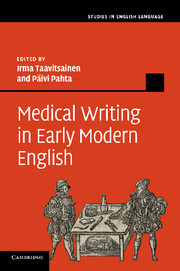Book contents
- Frontmatter
- Contents
- List of plates
- List of figures
- List of tables
- Notes on contributors
- Preface
- List of abbreviations
- 1 An interdisciplinary approach to medical writing in Early Modern English
- 2 Medical texts in 1500–1700 and the corpus of Early Modern English Medical Texts
- 3 Medical literacies and medical culture in early modern England
- 4 Verbs of knowing: discursive practices in early modern vernacular medicine
- 5 Defining in Early Modern English medical texts
- 6 Dissemination and appropriation of medical knowledge: humoral theory in Early Modern English medical writing and lay texts
- 7 Code-switching in Early Modern English medical writing
- 8 New arguments for new audiences: a corpus-based analysis of interpersonal strategies in Early Modern English medical recipes
- 9 Efficacy phrases in Early Modern English medical recipes
- 10 Medical pamphlets: controversy and advertising
- 11 The development of specialized discourse in the Philosophical Transactions
- 12 The expression of stance in early (1665–1712) publications of the Philosophical Transactions and other contemporary medical prose: innovations in a pioneering discourse
- Appendix A Raw data tables corresponding to Figures 4.3–4.14
- Appendix B Raw data tables corresponding to Figures 8.1–8.4
- Appendix C Stance markers used in the analysis in Chapter 12
- Appendix D Preliminary list of texts in the corpus of Early Modern English Medical Texts (EMEMT)
- Bibliography
- Index
10 - Medical pamphlets: controversy and advertising
Published online by Cambridge University Press: 03 May 2011
- Frontmatter
- Contents
- List of plates
- List of figures
- List of tables
- Notes on contributors
- Preface
- List of abbreviations
- 1 An interdisciplinary approach to medical writing in Early Modern English
- 2 Medical texts in 1500–1700 and the corpus of Early Modern English Medical Texts
- 3 Medical literacies and medical culture in early modern England
- 4 Verbs of knowing: discursive practices in early modern vernacular medicine
- 5 Defining in Early Modern English medical texts
- 6 Dissemination and appropriation of medical knowledge: humoral theory in Early Modern English medical writing and lay texts
- 7 Code-switching in Early Modern English medical writing
- 8 New arguments for new audiences: a corpus-based analysis of interpersonal strategies in Early Modern English medical recipes
- 9 Efficacy phrases in Early Modern English medical recipes
- 10 Medical pamphlets: controversy and advertising
- 11 The development of specialized discourse in the Philosophical Transactions
- 12 The expression of stance in early (1665–1712) publications of the Philosophical Transactions and other contemporary medical prose: innovations in a pioneering discourse
- Appendix A Raw data tables corresponding to Figures 4.3–4.14
- Appendix B Raw data tables corresponding to Figures 8.1–8.4
- Appendix C Stance markers used in the analysis in Chapter 12
- Appendix D Preliminary list of texts in the corpus of Early Modern English Medical Texts (EMEMT)
- Bibliography
- Index
Summary
Introduction
Pamphlets were a new genre of ephemeral texts that started to proliferate from the mid sixteenth century onwards. They were cheap and easy to print and distribute, and thus their prices were much lower than those of books. This made them potentially available to people of all social classes, and the practice of reading pamphlets aloud in coffee shops or even on street corners gave even the illiterate access to news, politics and advertisements (Shepard 1973: 13–14). The breakdown of censorship in 1641 caused an explosion in the numbers of printed titles, which can largely be explained by a shift from long folio and octavo works towards shorter quartos and broadsides in pamphlets and other forms of cheap print such as newsbooks (Raymond 2003: 168). Medical topics also multiplied, and while recipe books and general guides to medicine continued to be the most frequently published medical genres, a new genre of pamphlets advertising proprietary medicines became the third-most popular kind of medical publication in the second half of the seventeenth century (Fissell 2007: 114, Table 6.2). Pamphlets participating in medical as well as other controversies were another new genre, developing from the late sixteenth century onwards. These two kinds of medical pamphlets had different audiences: literate controversies had a limited readership of educated medical professionals, whereas advertisements had the widest readership possible and were probably read aloud like news pamphlets.
- Type
- Chapter
- Information
- Medical Writing in Early Modern English , pp. 180 - 203Publisher: Cambridge University PressPrint publication year: 2011
- 4
- Cited by



